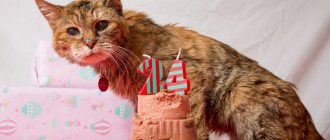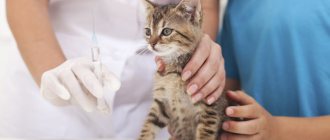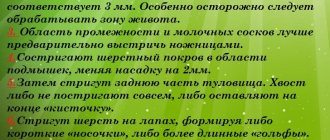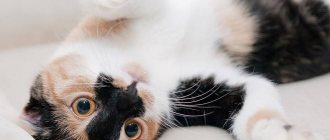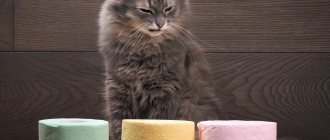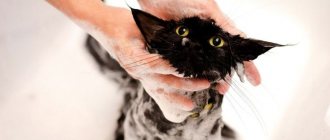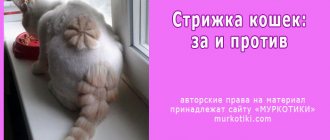High-quality cat care involves regular vaccination of the animal against dangerous diseases. Vaccinations for kittens are a mandatory procedure that does not depend on the lifestyle the pet leads. Even if the baby does not leave the apartment, he needs to be protected as much as possible from possible risks, since viral infections are often brought into the room along with the owner’s shoes and clothes.
Let's find out what vaccinations are needed for a Scottish kitten and how vaccination is carried out.
Schedule
Absolutely all Scots, regardless of ear shape (Scottish Fold or Scottish Straight), need regular vaccinations. The age at which the first vaccination is given depends on the type of feeding the kitten is fed.
Babies who feed on mother's milk receive immunity from the cat, so they are given the first vaccination at 3 months. Kittens that have already switched to artificial feeding are vaccinated at the age of 2 months.
Revaccination is carried out according to schedule.
Vaccination schedule for Scottish kittens:
| Disease prevention | Age of primary vaccination (in weeks) | Revaccination | Subsequent vaccinations |
| Rhinotracheitis | 8-12 | After 21 days | Annually |
| Panleukopenia virus (distemper) | 8-12 | After 21 days | Annually |
| Calicivirus | 8-12 | After 21 days | Annually |
| Chlamydia | 8-12 | After 21 days | Annually |
| Rabies | 12-14 | Need not | Annually |
| Leukemia | 8 | After 12 weeks | Annually |
When to vaccinate a Scottish cat: schedule and calendar
Below you will see the vaccination schedule for Scottish kittens, and also learn about how the first vaccination takes place.
Article continues after advertisement
It is never too late to vaccinate a cat that has not been vaccinated before. That is, there is no age limit, except for very old pets. If your cat is not currently feeling unwell and her body temperature is normal, then vaccination can be done safely at any age.
If everything is done according to the rules, then folds and straights need to be vaccinated starting from the age of two months. When to vaccinate a Scottish kitten also depends on when its mother stopped feeding it. Within 1-1.5 months, mother's milk contains antibodies and kittens receive them along with milk. Of course, only if she is vaccinated or has already developed antibodies to certain infections. In the case when kittens up to 1.5 months old, feeding on mother's milk, are vaccinated, the vaccine most likely will not work. Therefore, ideally, the first vaccination for a Scottish kitten is given at 2 months from the breeder. It can also be postponed by 2.5-3 months, if there are prerequisites for this.
Conscientious breeders should give the baby to the buyer at 3 months with all vaccinations, but in practice this does not always happen. Often babies are given to buyers at 1-2 months. As a result, the cat gets stressed from the move, after which it can pick up an infection in the new home, without the protection of maternal antibodies. And some breeders, giving the animal away at 3-4 months, still did not give the necessary injections, not bothering with the question of when the kitten should be given the first vaccination so that it is safe.
Suppose you decide to buy an animal that they are trying to give away without vaccinations and early. The first thing you need to do is ask the breeder to keep the kitten for up to 3 months and get vaccinations. That is, the ideal option is for Scottish kittens to be vaccinated in the breeder’s home. However, some breeders increase the price due to such a request. Although it would be correct to include the cost of the drug when calculating the price of an animal. If you take a kitten not from a professional nursery, but simply from a family where they decided not to sterilize the cat, but to let her reproduce, they may not want to keep the kitten for that long at all, much less vaccinate it. If so, either refuse such a purchase, or vaccinations will have to be done in the new home.
Give the cat the first week or two to adapt to the new home, because it’s already stressful. And vaccinations can only be given to a strong organism, in no case in a state of adaptation. During the couple of weeks that the cat lives with you, try not to bring foreign objects into the house from the street, do not bring animals home (even if they are friends’ animals, vaccinated and clean), hide outdoor shoes and thoroughly wash the floors to reduce the risk of contracting infections, which you can bring from the street. If you carry out the quarantine correctly, then, among other things, you will protect the animal from a situation where it is already infected with something and is injected with a vaccine during the incubation period. This could end badly.
The question of when to give a kitten his first vaccination is closely related to when he was given an anthelmintic drug. While the cat is adapting, he needs to be given anthelmintics: this is required before vaccination. You will read more about expelling worms in another article. After deworming, you need to wait about 10 days so that you can get the vaccine.
About a week before and for a week after vaccination, physiological and emotional stress should be eliminated. These include moving to a new place, changing food, walking outside, and the appearance of a new tenant in the house. Is it possible to bathe a kitten before or after vaccination? Not worth it. This is a lot of stress for him. If you really need to, for example, the baby is very dirty, try not to wash the whole thing, but only the dirty area. If swimming is completely unavoidable, then do not do it at least on the day of vaccination and for a day or two after it.
It is advisable to administer the very first vaccines at home, that is, call a veterinarian to your place, rather than taking your pet to the clinic. The fact is that while the kitten does not have immunity, it is generally undesirable to take it out of the house. According to veterinarians, many people get sick on the way to their first vaccination.
There are two vaccinations. The first includes the prevention of the most terrible diseases - panleukopenia, calicivirus infection and viral rhinotracheitis: drugs Nobivac, Multifel-4, Felocell, etc. The second vaccination is done after the period specified in the instructions and consolidates the result of the first. After the first vaccination, the kitten does not yet receive full immunity; its body is just becoming familiar with the contents of the injection. After the second vaccine, lasting immunity is developed.
Article continues after advertisement
Why is vaccination necessary?
Veterinarians insist on mandatory vaccination of all pets, regardless of whether there are other animals at home or whether the Scot will be walking outside. This need is caused by the high risk of illness from a virus that can accidentally enter the house.
Such infections include panleukopenia, calicivirus and others.
Important! Vaccinations and regular revaccination will protect Scottish kittens from most diseases.
How much does it cost to get vaccinated?
The cost of vaccinations for Scottish kittens is controversial. Domestic drugs are more affordable, while imported analogues are more expensive. Which vaccine to choose for immunizing a domestic cat is determined by the owner of the animal, taking into account the recommendations of the treating veterinarian.
The average cost of vaccines against the above diseases is 400-500 rubles.
Detailed information on this issue can be obtained from the veterinary clinic chosen for preventive immunization of the domestic cat.
What vaccinations does a Scottish kitten need?
There are a number of diseases of Scottish fold and straight-eared cats that pose a serious threat to the life of the animal. In order to protect the kitten, mandatory prevention in the form of vaccinations is necessary.
If the pet will be at home all its life
Even if the Scotsman is expected to spend his life in an apartment, the owner will have to vaccinate the kitten against the following diseases:
- panleukopenia (distemper);
- calicivirus;
- rhinotracheitis;
- rabies.
You cannot be sure that your pet will not “catch” the disease; it can only be insured through timely vaccination.
If the pet goes outside
Scottish kittens that will go for walks, participate in exhibitions, competitions, communicate with relatives of the opposite sex for mating, in addition to the above diseases, are additionally vaccinated against the following infections:
- leukemia virus;
- trichophytosis and microsporia viruses (ringworm);
- chlamydia.
Important! The first vaccination against lichen is given at the age of 8-12 weeks, repeated - after 10 weeks.
Types of vaccines for kittens
Complex vaccinations, which are given to kittens at three months of age, do not contain a vaccine against rabies, the most common and dangerous disease among pets. But the first stage of vaccination will protect your furry pet from the viruses of panleukopenia, rhinotracheitis and calicivirus. Often, the first trivalent vaccine also includes antibodies that help in the fight against chlamydia in adult cats. After some time, when the vaccine takes effect, revaccination is usually done using the same drug. This will help the kitten’s body to quickly develop lasting immunity against a specific disease.
The next stage of vaccination is vaccination against a disease that affects stray animals - rabies. Moreover, it is important not to miss the opportunity to perform such a procedure for those owners whose pets will be outside the city and walk the streets on their own. A popular vaccine for domestic cats is an injection that subsequently protects against ringworm and microsporia. It is usually carried out last. Thus, by 8-9 months of life, the kitten will have strong immunity to many infectious diseases. After all, forewarned means forearmed.
Preparing for vaccination
Sick Scottish Straight and Fold kittens cannot be vaccinated. Before the procedure, it is necessary to conduct a veterinary examination of your pet.
Two weeks before vaccination, treatment is carried out against fleas, ticks, and other external parasites and anthelmintic drugs are given. If, after prophylaxis, helminths leave the body, anthelmintic measures are repeated after 10-14 days. A scheduled vaccination for a Scot is carried out only after 2 weeks.
You need to reschedule the vaccination if:
- The kitten is teething;
- the animal looks lethargic and apathetic;
- the cat is pregnant or nursing kittens;
- the pet has suffered stress.
Preparatory stage
It is imperative to prepare for the immunoprophylaxis procedure in order to reduce the risks of adverse reactions. During preparation, a person is asked to perform several activities to improve the general condition of the pet:
- 14 days (2 weeks) before the intended vaccination, carry out deworming to drive away worms;
- simultaneously treat the coat with anti-flea and tick products;
- Before the procedure, the kitten must be examined by a veterinarian to rule out any health problems in the animal.
Medicines for parasites (helminths, fleas) are sold at any veterinary pharmacy. Antihelminthics are taken once 2 hours before eating. Ignoring the importance of holding an event is fraught with consequences. Worms block the formation of protective cells, as a result of which the effectiveness of vaccination decreases.
Only a healthy animal with no symptoms of dysfunction of internal organs can be vaccinated, namely:
- bowel disorders and poor appetite;
- discharge from the eyes of any nature;
- cough and rhinorrhea, frequent sneezing;
- increase in body temperature.
Fulfillment of all requirements regarding the correct organization of the preparation period is the key to effective and safe immunization.
Which vaccine should I choose for a Scot?
Vaccines for Scots are either complex or single-component. Complex drugs include drugs against several diseases.
These include: “Nobivak Triket Trio”, “Purevax”, “Multifel 4”, “Felovax 4”.
Single-component products are used to prevent one infection:
- leukemia – “Leukocel 2”;
- rabies – “Nobivak Rabies”, “Rabizin”;
- lichen – “Microderm”;
- chlamydia – “Chlamydia”, “Katavac Chlamydia”.
To vaccinate or not to vaccinate?
Whether your cat gets infected or not depends not so much on his health as on chance. For example, the causative agent of distemper (panleukopenia) is carried into an apartment on shoes, is not washed off when washing the floor, is not killed by disinfectants and attacks the animal, leaving practically no chance for it not to get sick. There are other, less terrible, but also unpleasant infections. Therefore, the cases of families where cats lived for years without vaccinations should not become an example for you. It's more likely just luck.
Another question is that the cat’s body’s reaction to a particular vaccination may be different. Some cats have allergies and may react to the vaccine with laryngeal swelling, vomiting, diarrhea or itching. But such cases are rare, about 1%, and allergy symptoms are easily eliminated.
In most cases, the first few hours after vaccination, the cat may suffer from drowsiness, apathy, loss of appetite and lethargy. But this condition usually lasts no more than a day and is absolutely normal. At this time, the pet does not need to be disturbed: most likely, it will just sleep.
In addition, vaccinations are a prerequisite for traveling to other countries, because At the border, your pet will undergo veterinary control. That is why information about vaccinations is included in the veterinary passport, which is issued by the animal doctor. Keep this document.
Of course, there is also the material side of the issue. Vaccinations must be of high quality, and high-quality material costs money. Typically, one shot costs approximately $2-$10, depending on the manufacturer. But if you compare this figure with the check for the cat’s treatment, the amount is simply ridiculous.
Care and monitoring of animals after vaccination
In the first days after the procedure, you need to pay special attention to the kitten’s health.
Tips for those who prefer to administer the vaccine to their pet themselves:
- Remove shoes and outerwear away from the cat.
- Clean the house thoroughly. Wash floors and rugs frequently.
- Ensure the cleanliness of animal products.
- Wash food and water bowls thoroughly.
- Limit the kitten's contact with other animals.
- Leave light foods and fruits in the Scots diet.
- Do not expose the animal to sudden changes in temperature.
- Do not bathe the kitten for several days.
Important! If vaccination is carried out in a veterinary hospital, the doctor should give recommendations on the care of the Scot for the first time after vaccination.
Rabies vaccination: time and features of vaccination
Vaccinations for British kittens also include vaccination against rabies. Nobivac Rabies will perfectly perform all the necessary functions. It should be remembered that this vaccination is classified as mandatory. In order for your pets to live long, it should be performed once a year. Moreover, it is worth paying special attention to the fact that this type of vaccination is special and should be done strictly separately from vaccinations against infectious diseases. However, this vaccination also has one more feature: for domestic British kittens who will not be near other animals in the house or have access to catching rats and mice, you can get a rabies injection after changing their teeth.
Possible complications and allergic reactions in a Scot
Vaccination, like any medical intervention, can cause a number of complications and allergic reactions. This depends not only on the quality of the vaccine, but also on individual intolerance to the drugs.
During the first time after the procedure, you may observe lethargy, apathy, and worsening sleep and appetite in your Scottish kitten. This is a normal reaction of the body to stress. These symptoms usually go away within a few days.
Vaccination sometimes causes complications. This happens more often if the vaccine was given to a sick animal.
The most common complications:
- diarrhea:
- impaired coordination of movements;
- loss of consciousness;
- vomit;
- convulsions;
- hair loss.
In such cases, you should immediately contact your veterinarian and follow his instructions.
Individual intolerance to the vaccine sometimes leads to allergic reactions with the following symptoms:
- diarrhea and vomiting;
- itching;
- loss of consciousness.
Important! Symptoms of an allergic reaction appear quickly. It is not recommended to leave the veterinarian within 30 minutes after vaccination. If an allergy appears, specialists will have time to take action.
Vaccines dead and alive
It is known what vaccinations a Scottish kitten needs. But which vaccine to give preference remains unclear. There are different types of vaccines for cats.
- Dead (inactivated vaccine), prepared from bacteria and viruses killed by high temperatures and chemical exposure. This type of vaccine is completely safe for animals, since its content is a dead environment.
- Live, prepared from weakened viruses and bacteria. Once in the animal’s body, microorganisms begin to develop, thereby developing natural resistance to infection.
A dead vaccine is used for rabies; both live and dead vaccinations can be used for infectious diseases. Regardless of the type of vaccination, the vaccination has the same effect on the animal’s body - it protects it from possible infectious diseases. Whether or not to vaccinate a Scottish kitten is a purely individual decision. Veterinarians recommend vaccinating the animal in any case, because some infections can not only kill the pet, but also be transmitted from the pet to its owner. Vaccination is the only effective protection against many diseases.
Caring for Scottish Fold kittens
Scottish Fold kittens, like adult representatives, need careful care. In our article we will look at how to properly keep such animals. Caring for a Scottish Fold kitten should be complete, that is, it is necessary to clean the eyes, ears, and nose. You should also comb and bathe your pet in a timely manner.
What other procedures are included in caring for a Scottish Fold kitten? Of course, cleaning the eyes. Generally, if they are healthy, there is no need to clean them. If your eyes become sour, wipe with a damp cotton swab dipped in a special liquid or water. You need to apply special medicinal drops over the eyeball.
If your kitten's tears are opaque, then most likely there is some kind of infection. To find out, you should contact your veterinarian.
Caring for a Scottish Fold kitten includes grooming. Such a pet should be periodically combed with a special brush (with frequent or rare teeth, depending on the length of the coat). It is desirable to have natural pile. Tangled fur should be untangled using lotion. If tangles appear, they are cut off.
Washing the kitten
Caring for a Scottish Fold kitten includes washing the pet. This should be done rarely: no more than once every three months. Of course, if a kitten gets dirty, then washing is a must. The first bath should be done carefully so as not to scare the animal.
Ear cleaning
What else is included in the complete care of a Scottish fold kitten? Of course, ear cleaning. This procedure needs to be done two to three (or more) times a month. To clean, use a cotton swab slightly moistened with a special liquid. Everything must be done carefully so as not to damage the sink. Clean your ears one at a time using different swabs.
You need to trim your claws regularly: twice (a couple of millimeters) a month will be enough. To do this, use special scissors. For grinding, you can buy a comfortable nail clipper for the kitten.
It is necessary to periodically examine your teeth. If you carry out hygiene procedures, you can prevent the occurrence of many diseases. It is necessary to clean plaque using a special brush and toothpaste. You need to get used to the procedure from childhood. First use just a brush, then moisten it with paste. Relatively soon the pet will get used to it.
What else is included in caring for a Scottish Fold kitten? Vaccinations are mandatory procedures. Before them, the kitten should be given an anthelmintic. The first deworming should be carried out at seven weeks, and the second at the age of three months before vaccination. Adults are subjected to this once a quarter.
For deworming, as a rule, the drug “Drontal Plus” is used. For small kittens, the children's medicine "Pyrantel" is used. How are kittens vaccinated? As a rule, they are vaccinated at the age of three months. Before vaccination, you should make sure that your pet is healthy and dewormed. After the first vaccination, revaccination is carried out 21 days later. The second vaccination is given at six months. Adult representatives - annually.
You can feed your pet natural food. The diet must be based on the following products: • beef, • lamb; • turkey meat; • eggs (one once a week); • chicken meat;
• low-fat dairy products.
Under no circumstances should you give your kitten fatty pork, smoked meats, or sweets. Raw river fish should not be added to food. Fatty dairy products should also not be included in the kitten's diet. How to feed prepared food? If you want complete care for your Scottish Fold kitten, choose high-quality food. It is advisable to choose super premium products. At the same time, the animal should always have clean water.
Vitamins should, of course, be given to the kitten during the first six months, or better yet, the entire first year. Which drugs should you choose? In this matter, you need to consult a veterinarian. He will definitely be able to choose the best option for vitamins.
Now you know how to care for a Scottish Fold kitten. As you can see, all procedures, in addition to vaccination, are quite simple to perform. We hope that you will be able to raise a healthy and beautiful pet. Good luck.
The Scottish Fold kitten (Scottish Fold) has a charming appearance, good health and a pleasant character. The pet quickly gets used to its new home and gets along with other animals without problems. In order for the baby to feel great and delight the owner every day, you need to provide him with proper care, create an ideal diet and not refuse to communicate.
Prepare everything you need before bringing your kitten home
Typically, Scottish Fold kittens are ready to leave their mother at the age of 2-3 months. At this time, their ears take on the desired shape, all breed characteristics become visible not only to a professional, but also to an ordinary amateur.
When preparing for the arrival of a kitten in the house, find out in advance what it ate from its previous owners and what kind of toilet filler it was used to. Responsible breeders supply customers with a small portion of food so that the baby feels more confident in a new place. Check the kitten's feeding schedule and habits.
Before you buy a kitten, buy everything you need for it. The baby will need:
- spacious carrying;
- bowls for food and water made of earthenware or stainless steel;
- litter tray;
- toilet filler;
- cat bed or house;
- bedding or pillow;
- toys;
- small veterinary first aid kit.
It is better to come to pick up your animal with a comfortable carrier. Buy a large carrier made of durable plastic; it will be useful for subsequent visits to the veterinarian and trips to the country. It is desirable that it has a firmly locked door, a comfortable handle, and numerous holes for ventilation. The bottom must be stable so that the carrier with the kitten does not tip over.
Organize a secluded place for your baby to sleep. You can ask the breeder for a rag from the cat's nest. The familiar smell will help the animal calm down and get comfortable in a new place.
It is important to keep an eye on your kitten's ears and eyes.
Touching folded ears are the calling card of a true Scot. It is important to ensure that they are always clean. At least once a week, wipe your ears with cotton swabs dipped in a special lotion. Do not use hydrogen peroxide, oil or alcohol.
Wipe your ears carefully, without penetrating the ear canal with the chopsticks. Do not twist or pull the ears to avoid causing pain to the kitten. Healthy ears do not have any discharge, perhaps a small amount of yellowish wax. If you find brown crusts, consult a doctor. Most likely, your pet has become infected with ear mites.
Itching, gurgling, and fluid discharge from the ears may indicate an inflammatory process that requires an urgent visit to the veterinarian. Do not try to diagnose it yourself; improper treatment will cause harm to your pet.
The kitten's eyes are wiped with a cotton swab dipped in disinfectant lotion. If the kitten constantly rubs its muzzle with its paw, shakes its head, and its eyes are festering and watery, consult a doctor. The cause of suppuration can be an injury to the eye or a foreign body trapped in it. Infectious diseases that require long-term treatment are also very dangerous: blepharitis, conjunctivitis, purulent keratitis.
Scottish kittens are not necessary, even contraindicated
Scottish Fold kittens do not require special coat care. It can be combed with a fine-toothed comb to remove loose hairs. It is enough to brush the kitten 1-2 times a week. A silicone mitten for smooth-haired cats will also help remove hair during shedding. It is not recommended to wash kittens; they can take care of their fur on their own.
Shampoo for cats not only gently washes the coat, but also slightly tints it. For white cats, a bluish product is suitable, giving the hairs a snowy shine. Shampoo for black or gray cats removes unsightly reddish undertones. These products are absolutely safe for animals.
A kitten's sharp, thin claws should be trimmed with special clippers for small animals. They give a straight cut without splitting the claw. During a cat manicure, only the very tip of the claw is removed. If you accidentally cut off excess, cauterize the affected area with hydrogen peroxide. It is not recommended for kittens to have their claws removed; silicone caps are not suitable for them either.
If the kitten eats dry food, special dental care will not be needed. Hard small granules remove plaque well, teeth and gums are strengthened. Professional removal of tartar is indicated for older animals; this procedure is done in the clinic under anesthesia.
cat house
Photo. cat house
Scottish fold kittens love comfort. Give them a comfortable basket in which you can put a soft pillow in a replaceable pillowcase. In the cold season, the kitten will appreciate the hammock bed, which is attached to the radiator. The resting place should be located in a secluded corner where there are no drafts or opening doors. Scottish Folds love to play, but get tired quickly. When the kitten is resting, no one should disturb him.
Special cat houses are very convenient. Kittens will enjoy complexes that include multi-tiered houses, observation areas, posts for claw points, and hanging toys. The most practical option is a plywood house trimmed with faux fur. If the kitten tears the cover, it can be easily replaced.
A board wrapped with ropes is suitable as a scratching post. Scottish Folds are happy to sharpen their claws on ordinary untreated wood. Even kittens who get regular manicures need a place for a claw point.


